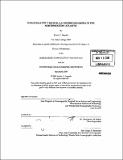Halogenated 1'-methyl-1,2'-bipyrroles (MBPs) in the Norwestern Atlantic
Author(s)
Pangallo, Kristin C
DownloadFull printable version (9.383Mb)
Other Contributors
Woods Hole Oceanographic Institution.
Advisor
Christopher M. Reddy.
Terms of use
Metadata
Show full item recordAbstract
Halogenated 1'-methyl-1,2'-bipyrroles (MBPs) are a distinctive class of marine organic compounds. They are naturally produced, they have a unique carbon structure, they are highly halogenated, and they bioaccumulate in upper trophic levels. MBPs share many characteristics with persistent organic pollutants (POPs), and may prove to be useful natural analogues for these anthropogenic compounds. Further, their unique structure suggests that their biosynthetic organism(s) may have new genes to add to current knowledge of biosynthetic chemistry. The objectives of this dissertation were to further clarify the environmental distribution of MBPs, to examine whether MBPs biomagnify, and to investigate possible origins of these compounds through their stable nitrogen isotopic signatures. Results from these investigations have shown that over 40 highly brominated MBP congeners are present in marine mammals, fish, and squid from the Northwestern Atlantic Ocean. The most abundant MBPs do appear to biomagnify through the food web to reach the concentrations observed in marine mammals. This additional evidence affords greater confidence in the use of MBPs as natural analogues for POPs. However, differences in the environmental chemistry of MBPs and anthropogenic compounds are also evident, and may be due to these compounds' different origins, or to the capacity of degradative enzymes to act upon them. (cont.) Finally, compound-specific nitrogen isotope analyses on MBPs isolated from dolphin blubber show that these compounds are dramatically enriched in 15N relative to other biosynthetic organic compounds. This enrichment is likely a signal imparted during biosynthesis, and may assist in elucidating the organism(s) and mechanism(s) responsible for the biosynthesis of MBPs.
Description
Thesis (Ph. D.)--Joint Program in Oceanography/Applied Ocean Science and Engineering (Massachusetts Institute of Technology, Dept. of Earth, Atmospheric, and Planetary Sciences; and the Woods Hole Oceanographic Institution), 2009. Cataloged from PDF version of thesis. Includes bibliographical references.
Date issued
2009Department
Joint Program in Oceanography/Applied Ocean Science and Engineering; Woods Hole Oceanographic Institution; Massachusetts Institute of Technology. Department of Earth, Atmospheric, and Planetary SciencesPublisher
Massachusetts Institute of Technology
Keywords
Earth, Atmospheric, and Planetary Sciences., /Woods Hole Oceanographic Institution. Joint Program in Oceanography/Applied Ocean Science and Engineering., Woods Hole Oceanographic Institution.